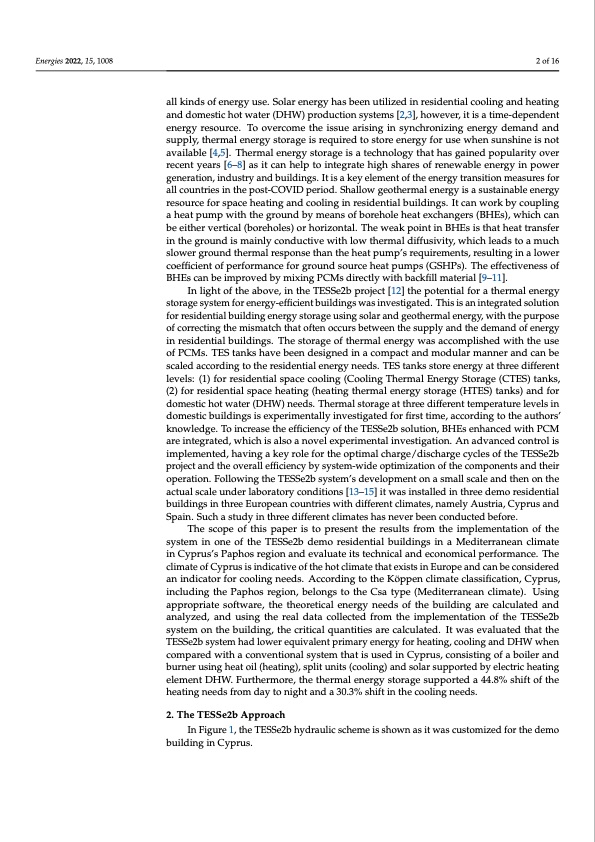
PDF Publication Title:
Text from PDF Page: 002
Energies 2022, 15, 1008 2 of 16 all kinds of energy use. Solar energy has been utilized in residential cooling and heating and domestic hot water (DHW) production systems [2,3], however, it is a time-dependent energy resource. To overcome the issue arising in synchronizing energy demand and supply, thermal energy storage is required to store energy for use when sunshine is not available [4,5]. Thermal energy storage is a technology that has gained popularity over recent years [6–8] as it can help to integrate high shares of renewable energy in power generation, industry and buildings. It is a key element of the energy transition measures for all countries in the post-COVID period. Shallow geothermal energy is a sustainable energy resource for space heating and cooling in residential buildings. It can work by coupling a heat pump with the ground by means of borehole heat exchangers (BHEs), which can be either vertical (boreholes) or horizontal. The weak point in BHEs is that heat transfer in the ground is mainly conductive with low thermal diffusivity, which leads to a much slower ground thermal response than the heat pump’s requirements, resulting in a lower coefficient of performance for ground source heat pumps (GSHPs). The effectiveness of BHEs can be improved by mixing PCMs directly with backfill material [9–11]. In light of the above, in the TESSe2b project [12] the potential for a thermal energy storage system for energy-efficient buildings was investigated. This is an integrated solution for residential building energy storage using solar and geothermal energy, with the purpose of correcting the mismatch that often occurs between the supply and the demand of energy in residential buildings. The storage of thermal energy was accomplished with the use of PCMs. TES tanks have been designed in a compact and modular manner and can be scaled according to the residential energy needs. TES tanks store energy at three different levels: (1) for residential space cooling (Cooling Thermal Energy Storage (CTES) tanks, (2) for residential space heating (heating thermal energy storage (HTES) tanks) and for domestic hot water (DHW) needs. Thermal storage at three different temperature levels in domestic buildings is experimentally investigated for first time, according to the authors’ knowledge. To increase the efficiency of the TESSe2b solution, BHEs enhanced with PCM are integrated, which is also a novel experimental investigation. An advanced control is implemented, having a key role for the optimal charge/discharge cycles of the TESSe2b project and the overall efficiency by system-wide optimization of the components and their operation. Following the TESSe2b system’s development on a small scale and then on the actual scale under laboratory conditions [13–15] it was installed in three demo residential buildings in three European countries with different climates, namely Austria, Cyprus and Spain. Such a study in three different climates has never been conducted before. The scope of this paper is to present the results from the implementation of the system in one of the TESSe2b demo residential buildings in a Mediterranean climate in Cyprus’s Paphos region and evaluate its technical and economical performance. The climate of Cyprus is indicative of the hot climate that exists in Europe and can be considered an indicator for cooling needs. According to the Köppen climate classification, Cyprus, including the Paphos region, belongs to the Csa type (Mediterranean climate). Using appropriate software, the theoretical energy needs of the building are calculated and analyzed, and using the real data collected from the implementation of the TESSe2b system on the building, the critical quantities are calculated. It was evaluated that the TESSe2b system had lower equivalent primary energy for heating, cooling and DHW when compared with a conventional system that is used in Cyprus, consisting of a boiler and burner using heat oil (heating), split units (cooling) and solar supported by electric heating element DHW. Furthermore, the thermal energy storage supported a 44.8% shift of the heating needs from day to night and a 30.3% shift in the cooling needs. 2. The TESSe2b Approach In Figure 1, the TESSe2b hydraulic scheme is shown as it was customized for the demo building in Cyprus.PDF Image | Latent Thermal Energy Storage Application

PDF Search Title:
Latent Thermal Energy Storage ApplicationOriginal File Name Searched:
energies-15-01008-v2.pdfDIY PDF Search: Google It | Yahoo | Bing
Turbine and System Plans CAD CAM: Special for this month, any plans are $10,000 for complete Cad/Cam blueprints. License is for one build. Try before you buy a production license. More Info
Waste Heat Power Technology: Organic Rankine Cycle uses waste heat to make electricity, shaft horsepower and cooling. More Info
All Turbine and System Products: Infinity Turbine ORD systems, turbine generator sets, build plans and more to use your waste heat from 30C to 100C. More Info
CO2 Phase Change Demonstrator: CO2 goes supercritical at 30 C. This is a experimental platform which you can use to demonstrate phase change with low heat. Includes integration area for small CO2 turbine, static generator, and more. This can also be used for a GTL Gas to Liquids experimental platform. More Info
Introducing the Infinity Turbine Products Infinity Turbine develops and builds systems for making power from waste heat. It also is working on innovative strategies for storing, making, and deploying energy. More Info
Need Strategy? Use our Consulting and analyst services Infinity Turbine LLC is pleased to announce its consulting and analyst services. We have worked in the renewable energy industry as a researcher, developing sales and markets, along with may inventions and innovations. More Info
Made in USA with Global Energy Millennial Web Engine These pages were made with the Global Energy Web PDF Engine using Filemaker (Claris) software.
Sand Battery Sand and Paraffin for TES Thermo Energy Storage More Info
| CONTACT TEL: 608-238-6001 Email: greg@infinityturbine.com | RSS | AMP |